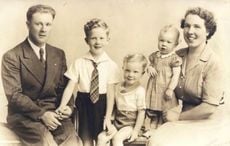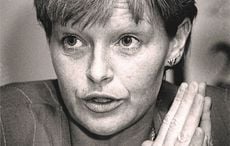Journalist Pete Hamill, the son of Belfast immigrants, passed away in New York City this morning, August 5, 2020. He was 85.
A note from Dermot McEvoy: I’ve interviewed Pete many times over the years and although Pete had been in failing health for years, the news still hit me hard. If it wasn’t for Pete I would have never had a book published. But because of his generosity and a helpful blurb I was able to get my fantasy novel about Michael Collins, Terrible Angel, published. One of my proudest moments was when I spied a copy of the book on his bookshelves in his apartment on Walker Street. God speed, Pete, you will be missed.
The following is an excerpt from Dermot McEvoy’s new book, "Real Irish New York," published by Skyhorse:
The one thing that strikes you about Pete Hamill when you read his writings or get to know him personally, is his profound sense of decency. It had to come from his parents, Billy Hamill and Anne Devlin. Anne was born in New York but returned to Belfast as a child. “Once [my grandfather] had his second child,” Hamill told me, “my mother and her brother, he decided he couldn’t live in Belfast as a Catholic. He had seen the world and he wanted to live—where else would you live?—in New York where nobody is going to say, ‘what are you?’; ‘what church do you go to?’ So he came to New York when my mother was a little girl. She was five when he got killed in an accident falling off a ship in Brooklyn.” Young Anne returned to Belfast to be brought up by relatives. She would return to New York in 1929 with an omen ringing in her ears—it was the day the stock market crashed.
Billy père was born in Belfast, and was a member of Sinn Féin. After a British soldier was blown up, according to Pete, “he went on the lam to Liverpool, and from Liverpool he came here.” Soon after arriving in America, Billy lost a leg in a football accident. Despite his handicap, he worked hard to support his wife and seven children. In 1933 Anne and Billy would meet and marry the next year. Pete was born in 1935.
Mother Anne had a great influence on the way the young Hamill learned to think. “I remember once we went to Times Square from Brooklyn,” Hamill told me, “because my brother Tom and I loved going to visit the Normandie [sunk in the north river by fire in 1942], which was on its side. Each time we got there, there was less of it because they were dismantling it. We were on our way there from Times Square and we passed what we called in those days a ‘bum’—he would now be called homeless—and he had a cup and he was begging, and my brother Tommy and I made some remarks about a ‘bum.’ And I must have been nine and Tommy was 7 and she got furious and said, ‘don’t you ever look down on anybody unless you’re giving them a hand to get up.’ I don’t think she was a saint. I think it was that whole generation of Irishmen and Jews and Italians and everybody in this town who felt you don’t look down on people. Help them because if you don’t help them who the fuck is going to help them? And it stayed with me all my life.”
The Writer as Mensch
In contrast to Breslin, you have Hamill, a mensch of a man, as they say at the corner saloon. Like many of the people they wrote about, both Breslin and Hamill came out of poverty, but Hamill was not tainted by it. His brother Denis, also a writer, perhaps put it best, “Poverty was not a sin.” Pete is honest in his progress as a man. His relationship with Robert Kennedy was remarkable and, in a way, tragic because he sent him a letter that convinced Kennedy to run for President. He was there when RFK was murdered and said he made a “terrible mistake as a journalist.”
“Pete’s a complicated man as well,” said Steve McCarthy, one of the director/producers of the HBO documentary "Breslin and Hamill: Deadline Artists." “His stories about stickball and bars in Park Slope reminded me of my own childhood in Bay Ridge,” McCarthy told me when the documentary premiered. “We weren’t wealthy but had food to eat and clean clothes. And, our parents valued education. Pete’s relationship with RFK had a major conflict in it. He, like many progressive Irish-Americans, fell in love with the Kennedys. They saw that this dynasty proved the Irish made it in America. They also saw how they didn’t forget where they came from. Instead of kicking the next guy coming up the ladder they extended a hand to help bring them up. The fact that both Pete and Jimmy were right there when RFK was shot is amazing. It makes for one of the most interesting parts of the film.”
Jimmy Wechsler Gives Hamill a Break
Until he was 25 Hamill made his living as a graphic artist. He wrote a letter to James Wechsler, editor of the New York Post, lamenting the lack of “working class” journalists at the paper. Wechsler invited Hamill to come in for a tryout—and the rest is history.
Hamill knows that in today’s world he couldn’t get inside the front door without the sheepskin. “I think that goes back to this immigrant mentality,” he told me, “that this is America and you can do anything. And I believed it! Today, in my case, with two years of high school, it’s not that you’d wouldn’t get to the editor, you’d never get past the personnel directors, who are making decisions based on resumes, which is insane. Jimmy Wechsler was a great man. He made my life possible.”
By the mid-’60s he was a columnist and that led to him writing books. His first novel was A Killing for Christ about an assassination plot on the Pope. He soon had a book of his collected columns called Irrational Ravings. Ironically, the title was suggested by then-Vice President and media basher and Nixon hatchet man Spiro T. (Nolo Contendere) Agnew, who had held up a Hamill column and exclaimed, “Listen to these irrational ravings!” Thanks, Spiro.
New York Is the Star of Hamill’s Books
Many of Hamill’s novels have New York at the center of the plot. Forever, Snow in August, North River, and Tabloid City are all located in New York. Once again, Anne Devlin was the great influence. “I think it goes back to the way I grew up,” said Hamill. “My father couldn’t move around New York because he only had one leg. So we knew New York—when I say New York I mean Manhattan because we were living in Brooklyn—we knew because our mother took us by the hand. When I say ‘we’ I mean me and my brother Tommy. She would take these two kids and show them and explain what Trinity Church was and that there were people called ‘Protestants,’ ” said Hamill with a laugh. “She never made comments making fun of anybody like that. So she would take us around to Chinatown and the west side piers because her father had worked for the Cunard Lines.”
I asked him about his urge to write fiction. “Before me and Jimmy [Breslin] there was very little tradition of American journalists writing novels. The instinct to make fiction was always there, even after I started to have some successes at journalism.”
He also has written nonfiction books that go in different directions, Why Sinatra Matters about Old Blue Eyes and A Drinking Life, a memoir of the young Hamill and his battle with drink. A Drinking Life has become an inspiration to many battling alcoholism and the book tells us a lot about the young Hamill and the maturation process that went into Pete’s life.
A Drinking Life is autobiography from afar because it traces Hamill’s life only until the time of his great alcoholic quenching, stopping in 1973. “It’s the kind of book about drinking that you can give a friend with the problem,” Hamill told me when I interviewed him for Publishers Weekly when the book came out. “It’s not saying: ‘For Chrissakes why don’t you get with the program?’ Here’ a guy talking honestly about it, as straight as he can, about facing your life. How do you want to live? Do you want to get old, or do you want to die?’ ”
“One of the things I didn’t want to do with the book,” Hamill continued, “was to make it into a sermon. I was saying, ‘this is how you begin to get into the culture of drinking.’ Because I think it is, in a sociological sense, a culture. What I have come to learn is that you can’t solve something like a drinking problem or a drug problem without examining the entire life.”
Hamill stopped drinking on his own. For him, there was no Betty Ford Clinic, AA meetings, or, as the Irish put it, “whiskey school.” “Somehow I knew that if I went to encounter groups, or to 12-steps, or to a shrink, or whatever, no matter what, I had to do it. It’s all up to you in the end, it’s your will that’s involved and our determination. It wasn’t a conscious thing: ‘I will not go to AA.’ I just said I’m going to stop.
“And I then began to use what I had,” he continued, “I was a writer. I began to keep a journal in which I tried to analyze the problem, which was the equivalent of standing up in front of a group. There were things I couldn’t figure out, or I thought I’d figured out, and didn’t realize until much later that I was wrong. But it ended up a benefit. I ended up kicking this thing.
“After the first year,” Hamill emphasized, “you get a point where you say, ‘Jesus Christ, I can’t even think about doing it again.’ The first year was far and away the hardest, the first six months in particular.”
Hamill, begrudgingly, even gives thanks to Lord Mountbatten—of all people—in inspiring him to stay on the wagon. “I remember a party in London where the guest of honor was Lord Mountbatten and the only other Irish person in the place was Edna O’Brien. It was one of these long, formal dinner tables with Mountbatten in the middle. And Mountbatten starts telling jokes. He’s one of the most boorish people I’ve ever met. And he starts to tell Irish jokes. And he starts to tell Irish drunk jokes. And at one point I lean back like this, and Edna leans back like this and looks at me and we laughed. He had no idea. To him, I was a Yank and Edna O’Brien was someone who lived in London. But I did have a feeling: I’ll never give these bastards the satisfaction of getting drunk in front of them.”
I asked him if he sees any connection between writing and drinking. “I think newspaper writers and drunks share a similar need for the instant reward. You’re attracted to the newspaper because your story will be in the paper tomorrow. Sometimes that night. You finish, you go to the bar, the first edition comes in and there it is. You get the instant kickback. You get the same thing with drinking.”
“My feeling was that if I was going to be any kind of a writer, it was going to take me a long time. I’d probably have to wait until my 50s to write my best stuff. Maybe 60s. But I couldn’t do it unless I could remember. Writers are rememberers or they’re nothing. And that remembering means remembering the pain and the grief and lousiness along with all the joys and triumphs and everything else.’
Hamill—Irish Ladies’ Man
Steve McCarthy and his partners in Breslin and Hamill: Deadline Artists dared to go where many fear to tread—Pete Hamill’s famous love life. He’s had dalliances with Jacqueline Onassis and Shirley MacLaine. (For the record, I once saw Pete in the Lion’s Head one night with Mary Tyler Moore—not bad for a kid from Park Slope, Brooklyn!) So, how did McCarthy do it? “As talented and handsome as Pete is, he is also modest. He did not boast about the glamorous women he went out with. He actually didn’t tell us much. When we asked him if he loved Jackie Onassis he replied: ‘I’d really agree with Garcia Marquez who said once, that everybody’s got three lives—a public life, a private life, and a secret life. Private life is by invitation only. A secret life is nobody’s business.’ ”
One of the highlights of the film is Breslin commenting on the love life of Hamill in a column, no less. “One of the funniest parts of the film,” says McCarthy, “was when Jimmy wrote a column about Pete going out with Jackie O and Shirley MacLaine at the same time. Shirley hit the roof, Jackie O laughed, and Pete was pissed off. He called Jimmy about it and Jimmy said, “I needed it” —meaning he needed something for a column that day.” Another funny Breslin-Hamill encounter was when Breslin said that the Son of Sam wrote so well he thought “Hamill wrote it!”
Read more about it in "Real Irish New York," which is available in hardcover and Kindle from Amazon.

Looking for Irish book recommendations or to meet with others who share your love for Irish literature? Join IrishCentral’s Book Club on Facebook and enjoy our book-loving community.
*Dermot McEvoy is the author of the recently published "Real Irish New York: A Rogue’s Gallery of Fenians, Tough Women, Holy Men, Blasphemers, Jesters, and a Gang of Other Colorful Characters." He is also the author of "The 13th Apostle: A Novel of Michael Collins," and the "Irish Uprising and Our Lady of Greenwich Village," both now available in paperback, Kindle, and audio from Skyhorse Publishing. He may be reached at [email protected]. Stay up-to-date on his website and Facebook page.




Comments